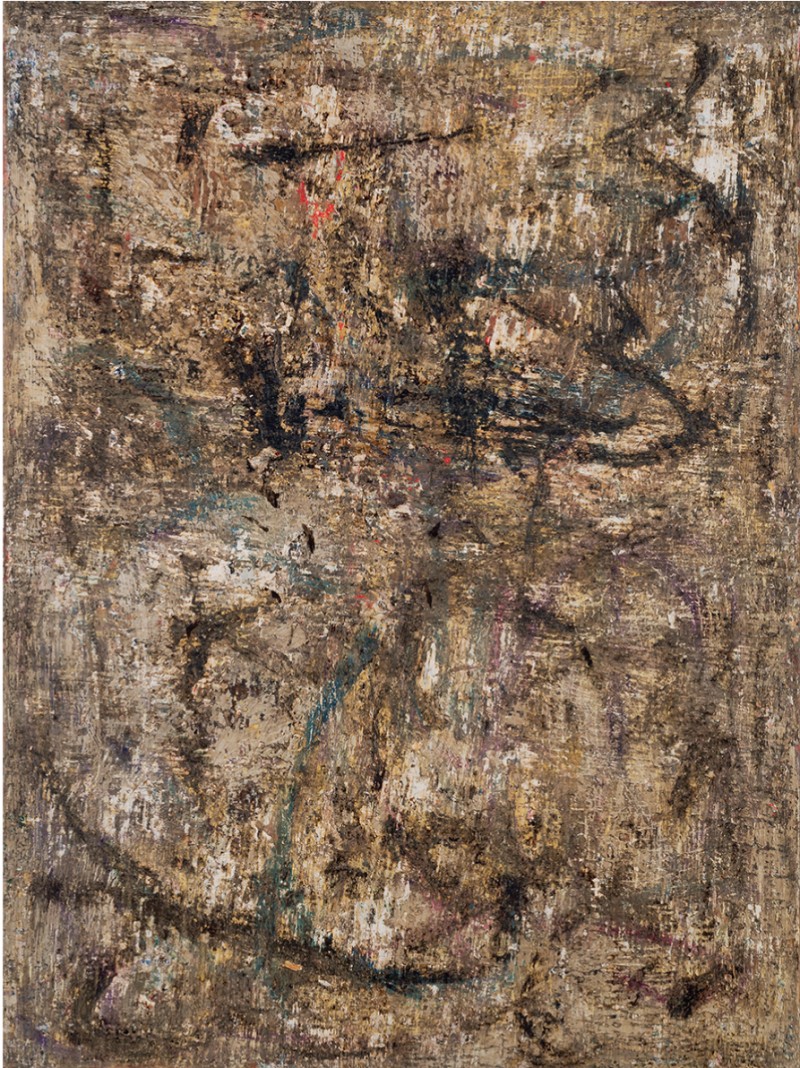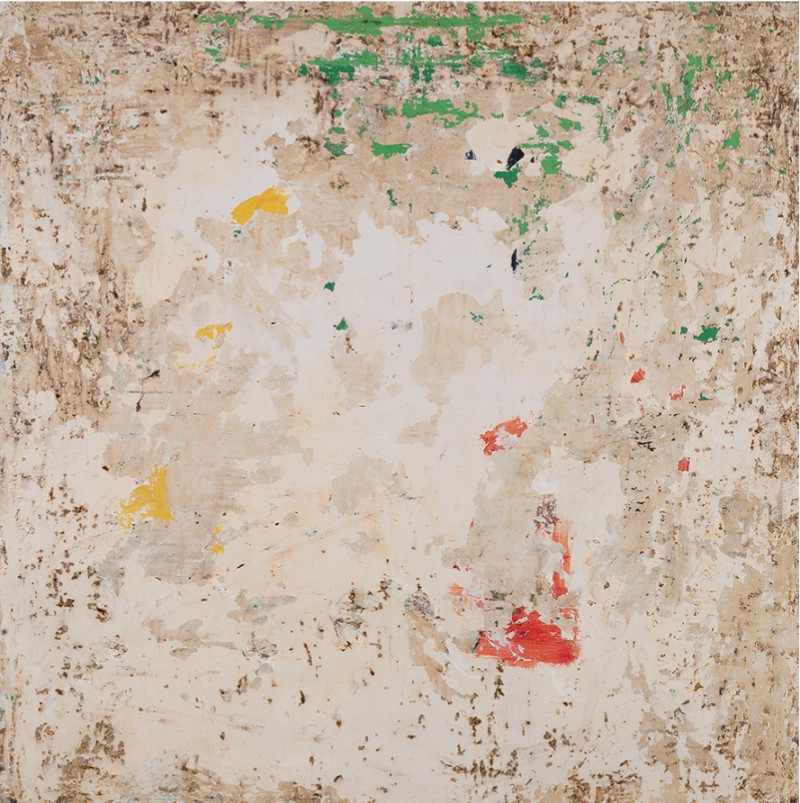Martin Pearce
Visually noisy yet neutral in tone, the 11 abstract non-compositions that make up Guelph-based artist Martin Pearce’s “Mud and Iron” seem to long for the palliative, soft-on-the-eyes aesthetic of an off-white wall. Up close, though, the futility of that longing emerges in the violent traces of Pearce’s process, by which paint and encaustic wax have not only been dabbed and brushed into thick layers but also scraped off, bored into and chipped away, revealing a blindingly complex catastrophe of colour and substance. This endless quarrying both multiplies the paintings’ strata and disperses them, pushing deep layers to the foreground while surface coats deviously sink. But by applying such an intensive method to his trademark aesthetic complexity, Pearce also evaporates out his work’s conceptual baggage. Left behind is a sharp, bitterly affective residue, in which Pearce substantiates the frustration of trying to resolve representation and reality’s infinite interconnectedness.

Martin Pearce, Once upon a time there was oil, 2018, oil, wax and tar on canvas, 72 x 54 inches. All images courtesy the artist and Birch Contemporary, Toronto.
Superficially, Pearce’s surfaces resemble natural substances like wood and rock, though with sufficiently alien colours, textures and figuration to make them seem eerily extraterrestrial. Yet, the show’s press release reveals a mimetic relationship with nature on a more primal level: here, Pearce centres contemporary Chinese artist and curator Bingyi’s idea that “much of the creation of the world … was done through destruction or through catastrophe,” framing his own works’ dynamic of creation and destruction alongside ecological collapse. While such themes have been taken up by perspectives as wide-ranging as anarcho-primitivism, climate-change activism and neoliberal defences of political economist Joseph Schumpeter’s “creative destruction,” Pearce’s take is both materially grounded and affectively inclined. On one hand, his process seems to frantically take away as much as it adds—by ruthlessly etching, scraping, slicing and scuffing every square centimetre of his canvases’ paint and encaustic. On the other hand, his attempts to annihilate every aspect of the work’s formal existence result neither in clarity nor in a blank slate, but in an overwhelming material presence. The contradiction calls to mind the double sided definition of “footprint,” which names both an indentation signifying absence and a measure of spatial accrual (building footprint), or consumptive hyperactivity (carbon footprint). The more Pearce struggles to redact his labour, the more its persistence is inescapably there.
In this sense, the emphasis on materiality, environmentality and physical and emotional investment displayed in “Mud and Iron” marks a departure from Pearce’s other recent projects, which more coolly thematize the play of mimesis across drawing, painting and photography. Still, the artist’s previous fascination with representation as such is baked into his newer works as well. While the broad, surface level brushstrokes that dominate Once Upon a Time There Was Oil, 2018, and Earth Clay and Salt, 2018, suggest calligraphic writing, the simultaneously representational and material quality of text is referenced in Above the Tide, 2018, whose black, white and dull brown texture is reminiscent of worm-eaten newsprint or papyrus. In Once Upon a Time There Was Oil especially (but on closer inspection across all of the exhibition’s works), the viewer’s eye is drawn to a few spots of brash, straight-from-the-tube colour— including a bright pink-red, but also burnt sienna and teal—that, rather than sitting atop the painting’s surface of distressed brown and grey, are dug out of its deepest notches as one of the canvas’s first layers of underpainting. Each of these colours is a sign, but not of anything originating in reality. Rather, as the three-colour motif of Tremolite, 2018, makes apparent, they stand for the medium of painting itself, signalling Pearce’s continued attention to excavating this ancient mimetic technology.

Tremolite, 2017, oil on canvas, 52 x 52 inches.
The world, in its infinite density, repeats itself in our representations. This sublime truth may be exhibited nowhere more clearly than in Pearce’s grids. Though they are present in only 7 out of 10 of the exhibition’s 72 x 54-inch paintings, these faint, identical nine-inch square grids are impossible to un-see once discovered, to the point that they are strongly implied in the works from which they are absent. During one of my visits to the gallery, I was told that Pearce’s inspirations for “Mud and Iron” included battlefield maps carried by World War II soldiers, which, aside from accruing layers of caked-on mud and earth, would be folded and refolded as they were stuffed back into pockets and rucksacks. Although they were produced on stretched canvas rather than creased paper, Pearce’s grids replicate the contingent materiality of these folds. Instead of being drawn, Pearce’s lines are physically scored into layers of oil paint, leaving streaky, dappled grooves of cut strata. At some points they are even visibly imperfect, having been rescored after a first attempt with a misplaced straightedge. But despite this evidence of human fallibility, the grids also reference the idealist project—common to both cartographers and military strategists—of cognizing Earth’s messiest landscapes from a literal and conceptual bird’s-eye view. In one sense, the grids’ attempt to order chaos—an attempt that is itself chaotic—reprises the frustration of a redactive method whose recurring outcome is nonetheless an explosion of more. Yet, the grids’ extrapolation across perspective, landscape and scale also transforms this affect into a universal condition, in whose wake a human’s (or a soldier’s) actions are no more significant than a termite’s.
As a result, the paintings in “Mud and Iron” become infinitely scalable topographies, offering fresh compositions at every level of detail. While their resemblance to landscapes is palpable, they can evoke almost any organic surface; for example, the tar-fringed melted wax bowls of Mud and Iron II, 2017, seem to flicker between volcanic craters and open, scabbing wounds. To complicate things further, the paintings’ perceptible layers are interspersed with perspectival ones, as when the paint-splotch archipelagos of Sourwood I, 2019, and Sourwood II, 2019, are circled in broad black lines, as if by a general planning an attack. But if the overall structure of the canvases remains inscrutable, it is not because Pearce has pursued complication for its own sake; rather, it is because the affective depth of his work is one with its product. In their passionate refusal to simplify or reduce, the works included in “Mud and Iron” make a claim that might seem difficult in this time: even when the world is collapsing around us, the strangeness of painting as an actor in that world remains impossible to ignore. ❚
“Martin Pearce: Mud and Iron” was exhibited at Birch Contemporary, Toronto, from March 6 to April 6, 2019.
John Nyman is a poet, critic and scholar from Toronto.

